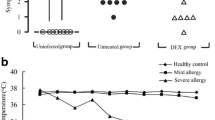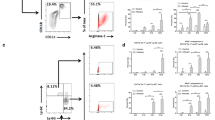Abstract
This study tested the hypothesis that immune tolerance mediated by regulatory T (Treg) cells is protective against cystic echinococcosis (CE)-induced anaphylactic shock. BALB/c mice were inoculated with protoscoleces of Echinococcus granulosus. After 3 months, the presence of cysts in the peritoneal cavity was confirmed after which a subset of mice was sensitized using a cyst fluid suspension to induce anaphylactic shock. While IgE levels were significantly higher in both groups inoculated with E. granulosus as compared to the healthy control group (both P < 0.01), sensitized mice had higher IgE levels as compared with those with E. granulosus alone (P < 0.05). Mice inoculated with E. granulosus alone and sensitized mice both had significantly higher histamine levels as compared to the healthy controls. The proportion of CD4+CD25+Foxp3+ Treg cells relative to CD4+ cells was significantly higher in mice inoculated with E. granulosus alone (P < 0.0167); significantly higher interleukin-10 (IL-10) and tumor growth factor-β (TGF-β1) levels were also noted in this group (all P < 0.01). In contrast, IL-13 and IL-17A levels were significantly higher in the sensitized mice (both P < 0.05). Taken together, these data suggest that the biphasic changes in Treg cell and cytokine levels may be associated with anaphylactic shock induced by CE.




Similar content being viewed by others
References
Ding ZX, Wen H. Atlas of echinococcosis. In: Wen H, Ding Z, editors. 2nd ed. Urumqi: Xinjiang People’s Science Press; 2008.
Eckert J, Deplazes P. Biological, epidemiological, and clinical aspects of echinococcosis, a zoonosis of increasing concern. Clin Microbiol Rev. 2004;17:107–35.
Thompson RC. The taxonomy, phylogeny and transmission of Echinococcus. Exp Parasitol. 2008;119:439–46.
Cao Y, Wen J, Zheng Q, Tang X, Dong Y, Zhang JP, et al. Prevalence of echinococcosis in Xinjiang Province in 2013. J Ningxia Med Univ. 2011;8:784–8.
Li Y, Zheng H, Cao X, Liu Z, Chen L. Demographic and clinical characteristics of patients with anaphylactic shock after surgery for cystic Echinococcosis. Am J Trop Med Hyg. 2011;85:452–5.
Zheng H, Xu ZX, Yang GX, Wen H. Study on the level of specific IgG, IgG1 and IgE during anaphylactic shock in sheep induced by Echinococcus granulosus. Chin J Parasitol Parasit Dis. 2003;21:42–5.
Vuitton DA. Echinococcosis and allergy. Clin Rev Allergy Immunol. 2004;26:93–104.
Moro P, Schantz PM. Echinococcosis: a review. Int J Infect Dis. 2009;13:125–33.
Simpson CR, Newton J, Hippisley-Cox J, Sheikh A. Incidence and prevalence of multiple allergic disorders recorded in a national primary care database. J R Soc Med. 2008;101:558–63.
Chen WF. Immune tolerance. In: Chen WF, editor. Medical immunology. Beijing: People’s Medical Publishing House; 2005. p. 181.
Yazdanbakhsh M, Kremsner PG, van Ree R. Allergy, parasites, and the hygiene hypothesis. Science. 2002;296:490–4.
Ma XM, Xu Q, Hou M, Ma HM, Wei XL, Li YJ, et al. Effects of Echinococcus granulosus infection on IL-17 level and Th1/Th2 balance in serum of asthmatic rats. Immunol J. 2011;02:123–7.
Mai Hepiretihan AE, Wang YH, Zhao JM, Wen H, Bai L. Echinococcosis multilocularis-induced immune tolerance after allograft heart transplantation in inbred rats. Chin J Exp Surg. 2011;28:1749–52.
Li T, Zhao JM, Paizula Ad, Cao J, Zhang Y, Zhang W, et al. Study on immune tolerance on orthotopic liver transplantation in the inbred rat infected with Echinococcosus multicularis. J Xinjiang Med Univ. 2006;29:940–2.
Iwasaki A, Medzhitov R. Regulation of adaptive immunity by the innate immune system. Science. 2010;327:291–5.
Sakaguchi S, Yamaguchi T, Nomura T, Ono M. Regulatory T cells and immune tolerance. Cell. 2008;133:775–87.
Palomares O, Yama G, Ahmet AK, Akkoc T, Akdis M, Akdis CA. Role of Treg in immune regulation of allergic disease. Eur J Immunol. 2010;40:1232–40.
Zhao L, Sun L, Wang H, Ma H, Liu G, Zhao Y. Changes of CD4+CD25+Foxp3+ regulatory T cells in aged Balb/c mice. J Leukoc Biol. 2007;81:1386–94.
Stock P, DeKruyff RH, Umetsu DT. Inhibition of the allergic response by regulatory T cell s. Curr Opin Allergy Clin Immunol. 2006;6:12–6.
Baz A, Hernandez A, Dematteis S, Carol H, Nieto A. Idiotypic modulation of the antibody response to Echinococcus granulosus antigens. Immunology. 1995;84:350–4.
Macintyre AR, Dixon JB. Echinococcus granulosus: regulation of leukocyte growth by living protoscoleces from horses, sheep, and cattle. Exp Parasitol. 2001;99:198–205.
Robinson RD, Arme C. Echinococcus granulosus: failure of eosin-exclusion test to demonstrate death of protoscoleces. Ann Trop Med Parasitol. 1985;79:117–23.
Riganò R, Buttari B, Profumo E, Ortona E, Delunardo F, Margutti P, et al. Echinococcus granulosus antigen b impairs human dendritic cell differentiation and polarizes immature dendritic cell maturation towards a Th2 cell response. Infect Immun. 2007;75:1667–78.
Sun J, Arias K, Alvarez D, Fattouh R, Walker T, Goncharova S, et al. Impact of CD40 ligand, B cells, and mast cells in peanut-induced anaphylactic responses. J Immunol. 2007;179:6696–703.
Wing K, Onishi Y, Prieto-Martin P, Yamaguchi T, Miyara M, Fehervari Z, et al. CTLA-4 control over Foxp3+ regulatory T cell function. Science. 2008;322:271–5.
Sakaguchi S, Miyara M, Costantino CM, Hafler DA. FOXP3+ regulatory T cells in the human immune system. Nat Rev Immunol. 2010;10:490–500.
Ma J, Wang H, Lin G, Zhao F, Li C, Zhang T, et al. Surveillance of Echinococcus isolates from Qinghai, China. Vet Parasitol. 2015;207:44–8.
Boufana B, Lett WS, Lahmar S, Buishi I, Bodell AJ, Varcasia A, et al. Echinococcus equinus and Echinococcus granulosus sensu stricto from the United Kingdom: genetic diversity and haplotypic variation. Int J Parasitol. 2015. doi:10.1016/j.ijpara.2014.10.005.
Shan JY, Li HT, Uerhongjiang T, Xiao J, Li L, et al. Dynamic observation of the expression of indoleamine 2,3-dioxygenase on the surface of dendritic cells induced by Echinococcus granulosus antigens. J Pathogen Biol. 2012;7:688–92.
Shan JY, Ji WZ, Li HT, Tuxun T, Lin RY, Wen H. TLR2, TLR4 expressions in peripheral blood mononuclear cells of patient with chronic cystic echinococcosis and its relationship with IL-10. Parasite Immunol. 2011;33:692–6.
Akbari O, Umetsu DT. Role of regulatory dendritic cells in allergy and asthma. Curr Allergy Asthma Rep. 2005;5:56–61.
Pan W, Zhou HJ, Shen YJ, Wang Y, Xu YX, Hu Y, et al. Surveillance on the status of immune cells after Echinnococcus granulosus protoscoleces infection in Balb/c mice. PLoS ONE. 2013;8:e59746.
Mourglia-Ettlin G, Marqués JM, Chabalgoity JA, Dematteis S. Early peritoneal immune response during Echinococcus granulosus establishment displays a biphasic behavior. PLoS Negl Trop Dis. 2011;5:e1293.
Pang N, Zhang F, Ma X, Zhu Y, Zhao H, Xin Y, et al. TGF-β/Smad signaling pathway regulates Th17/Treg balance during Echinococcus multilocularis infection. Int Immunopharmacol. 2014;20:248–57.
Margos MC, Grandgirard D, Leib S, Gottstein B. In vitro induction of lymph node cell proliferation by mouse bone marrow dendritic cells following stimulation with different Echinococcus multilocularis antigens. J Helminthol. 2011;85:128–37.
Amarasekera M, Gunawardena NK, de Silva NR, Douglass JA, O’Hehir RE, Weerasinghe A. Impact of helminth infection on childhood allergic diseases in an area in transition from high to low infection burden. Asia Pac Allergy. 2012;2:122–8.
Tuxun T, Wang JH, Lin RY, Shan JY, Tai QW, Li T, et al. Th17/Treg imbalance in patients with liver cystic echinococcosis. Parasite Immunol. 2012;34:520–7.
Ma X, Wang L, Zhao H, Pang N, Zhang F, Jiang T, et al. Th17 cells are associated with the Th1/Th2 cell balance during Echinococcus multilocularis infection. Mol Med Rep. 2014;10:236–40.
Jutel M, Akdis M, Budak F, Aebischer-Casaulta C, Wrzyszcz M, Blaser K, et al. IL-10 and TGF-beta cooperate in the regulatory T cell response to mucosal allergens in normal immunity and specific immunotherapy. Eur J Immunol. 2003;33:1205–14.
Wang J, Zhang C, Wei X, Blagosklonov O, Lv G, Lu X, et al. TGF-β and TGF-β/Smad signaling in the interactions between Echinococcus multilocularis and its hosts. PLoS ONE. 2013;8:e55379.
Kuchroo VK, Das MP, Brown JA, Ranger AM, Zamvil SS, Sobel RA, et al. B7-1 and B7-2 costimulatory molecules activate differentially the Thl/Th2 developmental pathways: application to autoimmune disease therapy. Cell. 1995;80:707–18.
Vuitton DA, Zhang SL, Yang Y, Godot V, Beurton I, Mantion G, et al. Survival strategy of Echinococcus multilocularis in the human host. Parasitol Int. 2006;55:S51–5.
Sun DQ, Zhang QY, Dong ZY, Bai F. Levels of IL-12 produced by dendritic cells and changes of TH1/TH2 balance in children with Henoch–Schonlein purpura. Chin J Contemp Pediatrics. 2006;8:307–10.
Jaffar Z, Ferrini ME, Girtsman TA, Roberts K. Antigen-specific Treg regulate Th17-mediated lung neutrophilic inflammation, B-cell recruitment and polymeric IgA and IgM levels in the airways. Eur J Immunol. 2009;39:3307–14.
Finkelman FD, Rothenberg ME, Brandt EB, Morris SC, Strait RT. Molecular mechanisms of anaphylaxis: lessons from studies with murine models. J Allergy Clin Immunol. 2005;115:449–57.
Ortona E, Vaccari S, Margutti P, Delunardo F, Rigano R, Profumo E, et al. Immunological characterization of Echinococcus granulosus cyclophilin, an allergen reactive with IgE and IgG4 from patients with cystic echinococcosis. Clin Exp Immunol. 2002;128:124–30.
Acknowledgments
This study was funded by grants from the National Natural Science Foundation of China (No. 81460309) and Research Award Fund of the First Affiliated Hospital of Xinjiang Medical University (No. 2013ZRQN43).
Author information
Authors and Affiliations
Corresponding author
Ethics declarations
Conflict of interest
The authors declare no commercial or financial conflict of interest.
Rights and permissions
About this article
Cite this article
Zhang, Q., Ye, JR., Ma, HM. et al. Role of immune tolerance in BALB/c mice with anaphylactic shock after Echinococcus granulosus infection. Immunol Res 64, 233–241 (2016). https://doi.org/10.1007/s12026-015-8741-2
Published:
Issue Date:
DOI: https://doi.org/10.1007/s12026-015-8741-2




